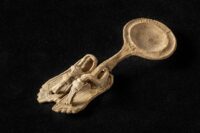 New research about the rare lead miniatures discovered in a Roman-era grave in Alba-la-Romaine, southern France, in 2020 has been published in the journal Archäologisches Korrespondenzblatt.
New research about the rare lead miniatures discovered in a Roman-era grave in Alba-la-Romaine, southern France, in 2020 has been published in the journal Archäologisches Korrespondenzblatt.
Occupied between the 1st century B.C. and the 6th century A.D., the ancient city of Alba Helviorum (modern-day Alba-la-Romaine) was the capital of the Celtic Helvii people. It was a large urban center at the foot of a volcanic plateau on the left bank of the Escoutay River. Just to the southwest were the crossroads of several well-travelled agricultural roads. It was at these crossroads that the miniatures were discovered in a 2020 preventative archaeology excavation.
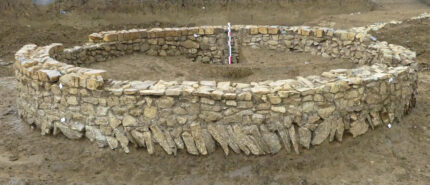 The waterlogged soil at the site was too humid to drain for cultivation, a fortuitous circumstance that ensured the survival of a small funerary complex founded in the Tiberian era under a mere 16 inches of topsoil. About 20 cremation burials and three inhumations from the early Roman empire (1st century B.C. until the end of the 2nd century A.D.) were discovered inside and surrounding a circular monument 20 feet in diameter made of limestone blocks.
The waterlogged soil at the site was too humid to drain for cultivation, a fortuitous circumstance that ensured the survival of a small funerary complex founded in the Tiberian era under a mere 16 inches of topsoil. About 20 cremation burials and three inhumations from the early Roman empire (1st century B.C. until the end of the 2nd century A.D.) were discovered inside and surrounding a circular monument 20 feet in diameter made of limestone blocks.
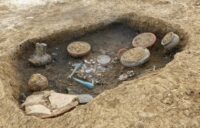 South of the monument, archaeologists found a mixed cremation burial — both cinerary remains and an ossuary — dating to between 60 and 100 A.D. The cinerary remains were at the bottom of a rectangular pit. A ceramic pot was placed on the remains and then on top of that was the ossuary (a bag or box containing bones). The burial was richly furnished. Burned with the body were a juvenile rooster, a lamp, a plate, a ceramic vase, twelve glass vases, a gold ring, shoe nails and a token made of bone. Unburned offerings included two balsamaria, a glass jug, seven small ceramic containers, two copper alloy mirrors and the exceptional lead miniatures. The mirrors and the small diameter of the ring suggest this was a woman’s grave, although the sex could not be conclusively determined from the remains.
South of the monument, archaeologists found a mixed cremation burial — both cinerary remains and an ossuary — dating to between 60 and 100 A.D. The cinerary remains were at the bottom of a rectangular pit. A ceramic pot was placed on the remains and then on top of that was the ossuary (a bag or box containing bones). The burial was richly furnished. Burned with the body were a juvenile rooster, a lamp, a plate, a ceramic vase, twelve glass vases, a gold ring, shoe nails and a token made of bone. Unburned offerings included two balsamaria, a glass jug, seven small ceramic containers, two copper alloy mirrors and the exceptional lead miniatures. The mirrors and the small diameter of the ring suggest this was a woman’s grave, although the sex could not be conclusively determined from the remains.
The lead miniatures were found grouped together on the north side of the pit, centered along the wall. One was a pair of sandals attached to a coat hook; another was a set of strigils on a ring. The sandals were placed upright with the hook covered by the strigils. This positioning indicates the miniatures were deposited at the same time in a container that decomposed over time but left them in the positions they had already been placed in.
The sandals are of a simple design: soles with straps connecting the toes to the instep with a buckle at the heel. They were decorated on both sides with beads. The lead miniature appears to have been meticulously rendered to match the construction of actual sandals from this period. Under the heel is a circle crossed out with a cross, which may have been a version of the theta nigrum, symbol of death. Attached to the strap of one of the sandals is a patera, a shallow basin used for libation. It is decorated with a guilloche border and rests on a base of concentric circles. This too is consistent with the design of actual paterae.
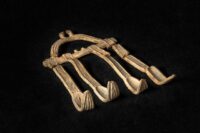 The strigils are also realistic, as the full-sized tools were often linked together with a D-ring. The scraping edges are proportionally short, less elongated than on most strigils, and have a sharp, almost right-angled turn which corresponds to a specific kind of strigil that was popular in Gaul in the 1st century A.D. They are attached to a D-ring via perforations in the top of the handles, but in fact they were cast all at once, not one at a time and then connected as real strigils were.
The strigils are also realistic, as the full-sized tools were often linked together with a D-ring. The scraping edges are proportionally short, less elongated than on most strigils, and have a sharp, almost right-angled turn which corresponds to a specific kind of strigil that was popular in Gaul in the 1st century A.D. They are attached to a D-ring via perforations in the top of the handles, but in fact they were cast all at once, not one at a time and then connected as real strigils were.
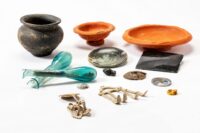 Roman miniatures are typically found in sanctuaries and tombs, with significantly higher numbers of them found in sanctuaries where people left them as votive offerings. Most of them are made of iron, terracotta or copper. Lead miniatures are rare on the archaeological record. The realism of the utensils is also rare. Sanctuary votive miniatures are usually very simplified compared to the functional objects.
Roman miniatures are typically found in sanctuaries and tombs, with significantly higher numbers of them found in sanctuaries where people left them as votive offerings. Most of them are made of iron, terracotta or copper. Lead miniatures are rare on the archaeological record. The realism of the utensils is also rare. Sanctuary votive miniatures are usually very simplified compared to the functional objects.
The symbolism of these miniatures being included as funerary furnishings in a 1st century Gallo-Roman community goes beyond the reference to bathing and clothes. These were symbols of Roman culture, and their placement in the grave of a wealthy woman in Alba Helviorum is evidence of how the elite adopted the Roman way of life.